Elbows
It's
10 o'clock; do you know where your elbows are?
Elbows are a really interesting thing. In some
ways, they're very simple. In other ways, they're
very misunderstood.
To begin with, do you know whether your elbow is
attached to your forearm or your upper arm? If you
don't know right off the bat, it only takes a moment or so
to sort this out. Grab hold of the bony part of your
elbow. If you feel up your arm and down your arm, you
can find where the bones go. The bone attached to
your elbow, the ulna, is the one you want on the
bottom. Even during riding.
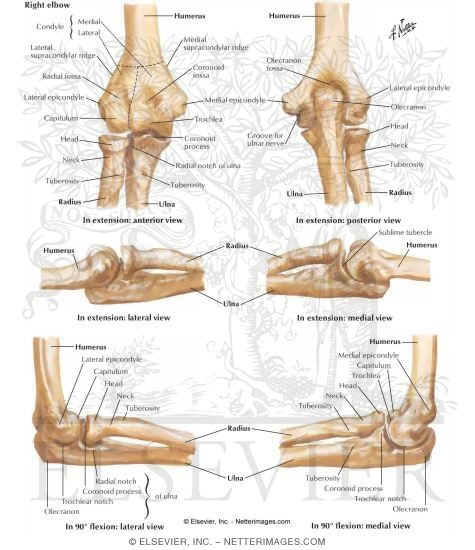 |
| footnote: Netter has done some
fabulous work! I actually own these cards;
they are fabulous! but I lifted this pic off
the internet. |
Where do you put your elbows when you're riding?
Most folks are initially taught to put their hands at
the wither. This is because it's a place on the horse
that often maintains the same distance from the horse's
mouth. (Because a lot of horses have been schooled
with side reins attached near there and have learned
to keep their mouths stationary at the end of the side reins.)
It also assumes that the rider has the correct torso:arm
length ratio for making this functional.
It's also a place where new riders can steady
themselves, with the idea it's better to put weight on the
hands on the withers when learning to ride.
You'll notice there's a lot of 'ifs.'
One of things which often happens when a rider puts
their hands 'on the wither' is that the elbows are now in
front of the body. This is not good.
Check it out.
Put your elbows ahead of your body with your hands out
in front of you like you're putting a tray on a
counter. Now hold this. Hold it some
more. How's your lower back doing? How're your
upper shoulders doing? Where does your weight
go? Into your seat or up into your chest? Are you starting to tip at
all? (notice this the next time you're on a horse!)
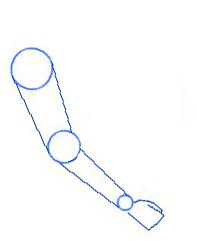
Now line your elbows up with the seams on your shirt and
hold your hands in front of you a little higher than your
elbows. Now hold this. Hold it some
more. How's your lower back doing? How're
your upper shoulders doing? Where does your weight
go? Into your seat or up into your chest? Are you starting to tip
at all? (notice this the next time you're on a
horse!) Are you more secure?
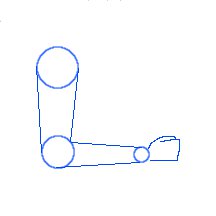
Next question: are your elbows moving?
Now, what do you do with your elbows? This is a
joint! Joints move. Do your elbows move when
you ride? Do they open and close?
This is what a lot of elbows do:
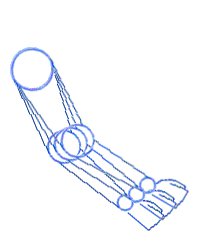
These elbows aren't bending, and what happens is the
hand goes up and down. Usually not at all in
sync with the horse's mouth.
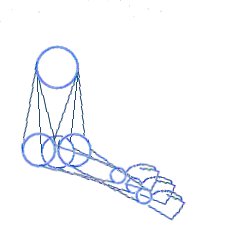
This shows the hand lifting as the
elbow oscillates behind the plumb line and dropping as the
elbow oscillates in front of the plumb line. This is
a little exaggerated for illustrative purposes; however,
next time you're on the horse, notice if the movements,
which are smaller, are similar to this. This is also
more indicative of a walk on a loose rein where the horse
has its head down. This is where you'll get the most
movement and you can practice finding your joints.
Where you put your hand depends upon where your
horse's mouth is.
On a high level horse, the hands will rest
parallel to the ground and move up.
Ideally there is a straight line between the elbow and
the horse's mouth at all times.
  
What's the benefit of this?
When you allow your shoulders and elbows to move, you
communicate to the horse that they are expected to be moving
their shoulders and elbows. Goodness.
When you stiffen your elbows and shoulders, you communicate to
the horse that they are expected to stiffen their elbows and
shoulders. Badness.
  
An Approach
One of the concepts I find the most beneficial comes from
swimming the crawl properly. When you're pulling
your arm out of the water, the movement is led with the
elbow. When you stretch your arm forward, the movement
is led with your hand. This alternating reach - elbow
to the back, hand to the mouth, guides the arm as well.
Another concept is dueling rubber bands. One is
connected from the elbow to the tail and the other is
connected from the hand to the mouth. They take
turns pulling the forearm. The trick to this is to allow
the image to move your arm.
There are a bunch of other concepts, too, and there's a lot
more to how to hold the hand, how to free the shoulder, how to
do all kinds of things!
Interested? Call or email or pm and and set up a
lesson! This is what I teach. Let me share with
you how
to use these concepts for greater understanding and
harmony with your horse. The fabulous rides follow.
Lynn
Centered Riding Instructor & Level
III Clinician
|




![Centered Riding Today: An Informal Talk by Sally Swift [VHS]](http://ecx.images-amazon.com/images/I/41Vn6PfhzML._SL125_.jpg)
![Centered Riding with Sally Swift [VHS]](http://ecx.images-amazon.com/images/I/51OSh9kd9iL._SL125_.jpg)




